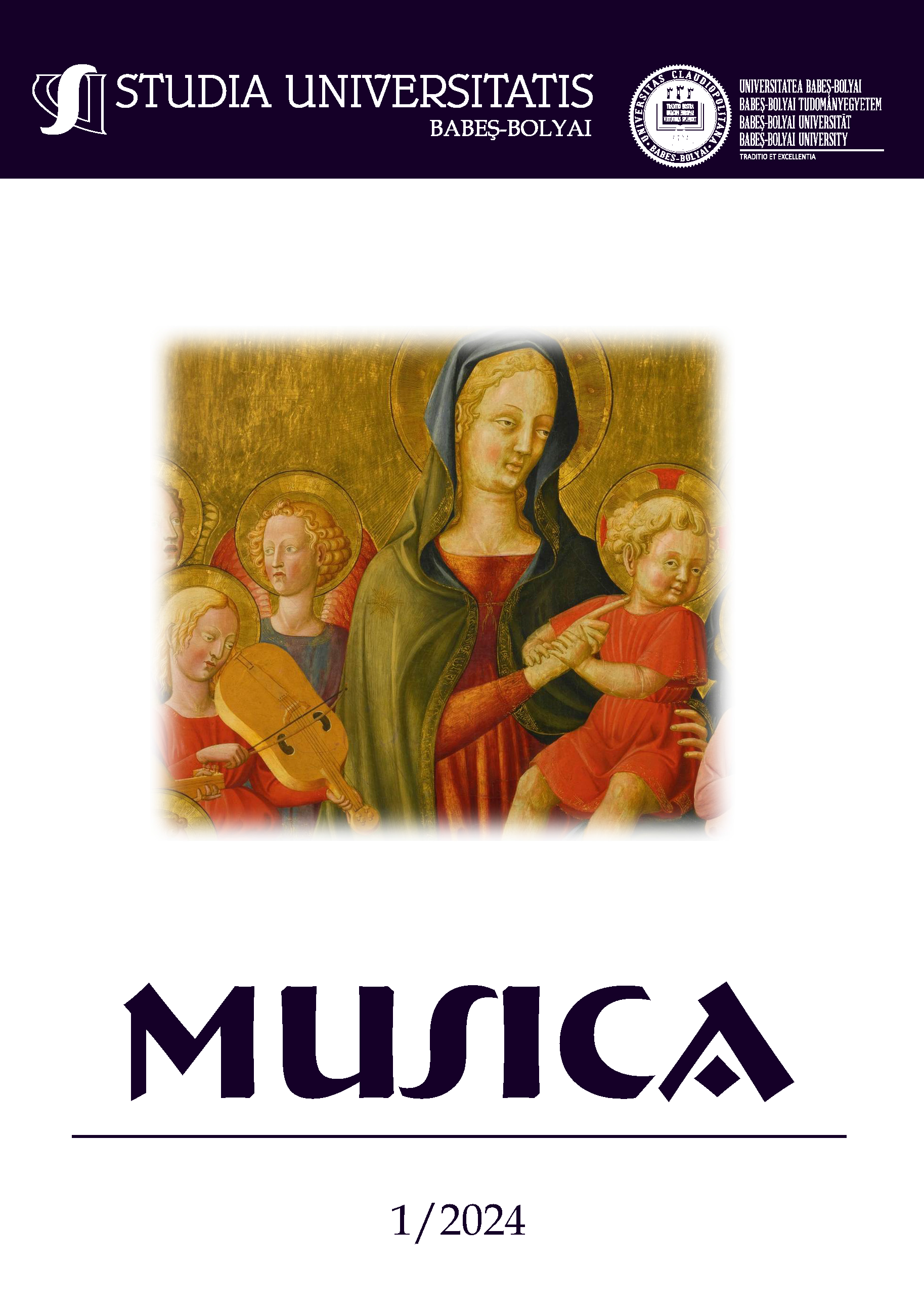An Analysis of F. Chopin’s Music Language in Terms of Melody, Harmony and Rhythm
DOI:
https://doi.org/10.24193/subbmusica.2024.1.12Keywords:
F. Chopin, melody, rhythm, harmony, music languageAbstract
Frédéric Chopin (1810-1849), one of the composers who reflected and created the spirit of the ‘Romantic Period,’ characterized by increased diversity in style, form, and expression, and the expansion of piano literature, crafted the musical texture in his pieces with a highly personal style, incorporating his unique harmony, flexible formal design, original use of expressive tools, and a free performance technique that didn’t adhere to rigid patterns in rhythm and tempo. Chopin’s distinctive style is particularly visible in the forms he chose for piano music. The flexible forms of his time allowed the composer to create a characteristic style by freely utilizing musical materials. Especially, forms like nocturnes, fantaisies-impromptus, and waltzes, which leave an impression of improvisation, small-scale, and rule-free structures, provided a clear space for the composer’s expressive tools. Indeed, it is possible to identify Chopin’s musical language, especially through his small-scale pieces. The purpose of this research is to analyze the melody construction, harmony, and rhythms of Frédéric Chopin (1810-1849), focusing on selected pieces to provide an interpretation of his musical language based on similarities found in these pieces. Samples from Chopin’s literature, including Op. 27 No. 1, Op. 9 No. 2 and No. 20 Nocturnes, Op. 64 No. 2 Waltz, and Op. 66 Fantaisie-Impromptu, were taken for the study. The research employed a case study design within qualitative research methods, and the obtained data was described descriptively. In conclusion, it was found that Chopin’s harmony encompasses a wide range from simple chord progressions to complex chords. He created simple yet bel canto melodies inspired by the ‘Italian Opera’ embellishments and used rhythms that prioritize the clarity of melody rather than a polyrhythmic approach. This study is believed to contribute to listening and playing practices due to its exploration of the musical materials in the Turkish literature related to Chopin.
References
Aliyeva, Mehriban. “Frederic Chopin’in Minyatürlerinde Mazurkalar.” The Journal of Academic Social Science, vol. 9, no. 123, 2021, pp. 206-224, doi:https://doi.org/10.29228/ASOS.54206.
Bielecki,Artur.”Impromptus.”https://chopin.nifc.pl/en/chopin/gatunki/10_impromptus. (Accessed 01.01. 2024, 16 o’clock).
Bielecki, Artur. “Nocturnes.” https://chopin.nifc.pl/en/chopin/gatunki/11_nokturny. (Accessed 2024, 16 o’clock).
Björling, David. “Chopin and the G Minor Ballade.” Student thesis, 2002. http://urn.kb.se/resolve?urn=urn:nbn:se:ltu:diva-515872016-10-04t16:22:57.240+02:00.
Coca, Gabriela. “Fryderyk Chopin, a Forerunner of the Harmony of the 20th Century.” Studia Universitatis Babes-Bolyai, Musica, vol. 55, no. 1, 2010, pp. 107-116.
Collier, Kaitlyn. “Chopin’s Musical Elements.” Masters Theses, 2020. https://digitalcommons.liberty.edu/masters/676.
Duncan, Carolyn. Aesthetic Elements in the Music of Chopin. University of Wyoming, 1985.
Eigeldinger, Jean-Jacques “Chopin And’la Note Bleue’: An Interpretation of the Prelude Op. 45.” Music & Letters, vol. 78, no. 2, 1997, pp. 233-253.
Elivar, Emre. “Chopin’in Piyano Sonatları.” Etnomüzikoloji Dergisi, vol. 3, no. 1, 2020, pp. 105-125, https://dergipark.org.tr/en/download/article-file/1208142.
Eral, Nurlu. “Schumann ve Chopin Piano Eserlerinin Yapısı ve Yorumu Yönünden Karşılaştırmalı Incelenmesi.” Fen Bilimleri Enstitüsü, Master Thesis, Marmara Üniversitesi, 1989. https://tez.yok.gov.tr/UlusalTezMerkezi/tezSorguSonucYeni.jsp.
Gide, André. Chopin Üzerine Notlar. Can yayınları, 2010. 4.
Gorbaty, Jan. “Polish Folk Music and Chopin’s Mazurkas.” Chopin Journal, vol. 1, no. 1, 1986, pp. 10-11.
Gorea, Ioana Luminița. “Romantic Characteristics Reflected in the Works of Fryderyk Chopin.” Studia Universitatis Babes-Bolyai, Musica, vol. 56, no. 2, 2011, pp. 109-115.
Huneker, James. Chopin: The Man and His Music vol. 1, Courier Corporation, 1966.
Mullen, Alexandra. “In Search of Chopin.” The Hudson Review, vol. 56, no. 4, 2004, pp. 695-702, doi:https://doi.org/10.2307/3852970.
Pamir, Leyla. Müzikte Geniş Soluklar. Boyut kitapları, 2000.
Samson, Jim. “Chopin and Genre.” Music analysis, vol. 8, no. 3, 1989, pp. 213-231.
Smith, Gabriella. “Frederic Chopin: More Than a Polish Man.” https://gabriellaksmith.com/wp-content/uploads/2020/04/Term-Paper-for-Late-Romantic-and-20th-Century-Lit-2.pdf.
Sönmezöz, Feyza. “Formal Analysis of Frédéric François Chopin’s Polonaise “Militaire” in Op.40 No.1.” Art and Interpretation, vol. 39, no. 1, 2022, pp. 67-76, doi: 10.54614/AI.2022. 991577.
Springer, Bethany. “Nocturne: The Life and Music of Chopin.” A Senior Project presented to the Faculty of the Music Department at California Polytechnic State University, San Luis Obispo, 2015.
Swartz, Anne. “Folk Dance Elements in Chopin’s Mazurkas.” Journal of musicological research, vol. 4, no. 3-4, 1983, pp. 417-425, doi:10.1080/01411898308574539.
Şimşek, Hasan and Ali Yıldırım. Sosyal Bilimlerde Nitel Araştırma Yöntemleri. 8 edition, Seçkin, 2011.
Thomas, Betty Jean. “Harmonic Materials and Treatment of Dissonance in the Pianoforte Music of Frederic Chopin.” Ph.D. diss., Eastman School of Music, 1966. https://vmirror.imslp.org/files/imglnks/usimg/4/4b/IMSLP47190-PMLP02305-Chopin_Nocturnes_Schirmer_Mikuli_Op_27.pdf (Accessed 01.01. 2024, 15 o’clock).
https://imslp.org/wiki/Nocturne_in_C-sharp_minor,_B.49_(Chopin,_Fr%C3%A9d%C3%A9ric), (Accessed 01.01. 2024, 15 o’clock).
https://imslp.org/wiki/Nocturnes,_Op.9_(Chopin,_Fr%C3%A9d%C3%A9ric) (Accessed 01.01. 2024, 15 o’clock).
https://imslp.org/wiki/Waltzes,_Op.64_(Chopin,_Fr%C3%A9d%C3%A9ric) (Accessed 01.01. 2024, 15 o’clock).
https://imslp.org/wiki/Fantaisie-impromptu,_Op.66_(Chopin,_Fr%C3%A9d%C3%A9ric), (Accessed 01.01. 2024, 15 o’clock).
Downloads
Published
How to Cite
Issue
Section
License
Copyright (c) 2024 Studia Universitatis Babeș-Bolyai Musica

This work is licensed under a Creative Commons Attribution-NonCommercial-NoDerivatives 4.0 International License.






